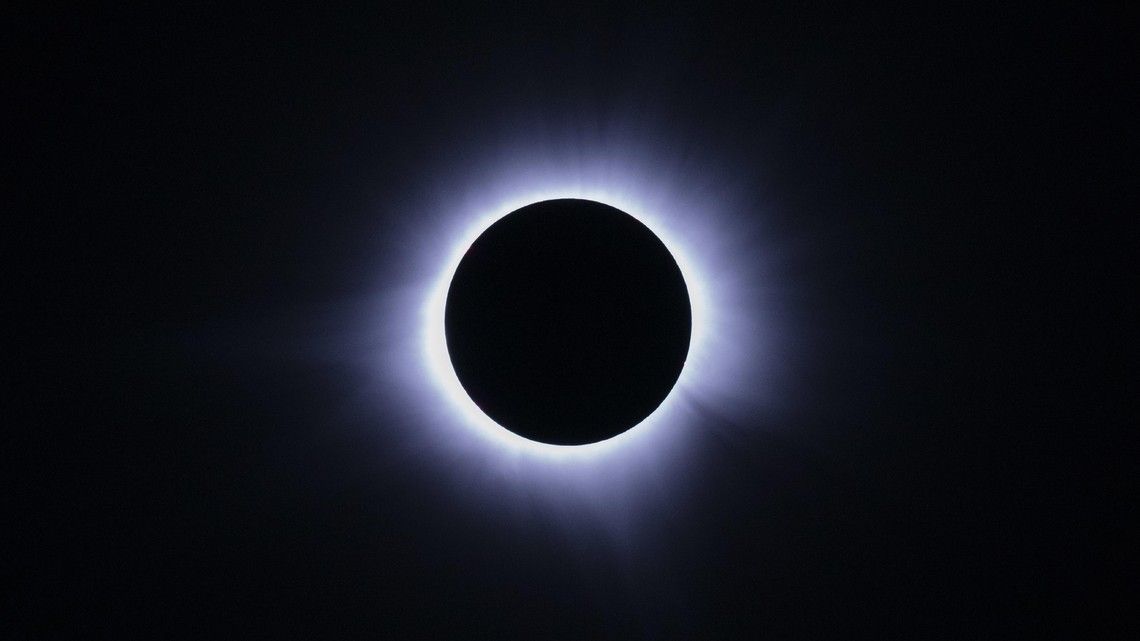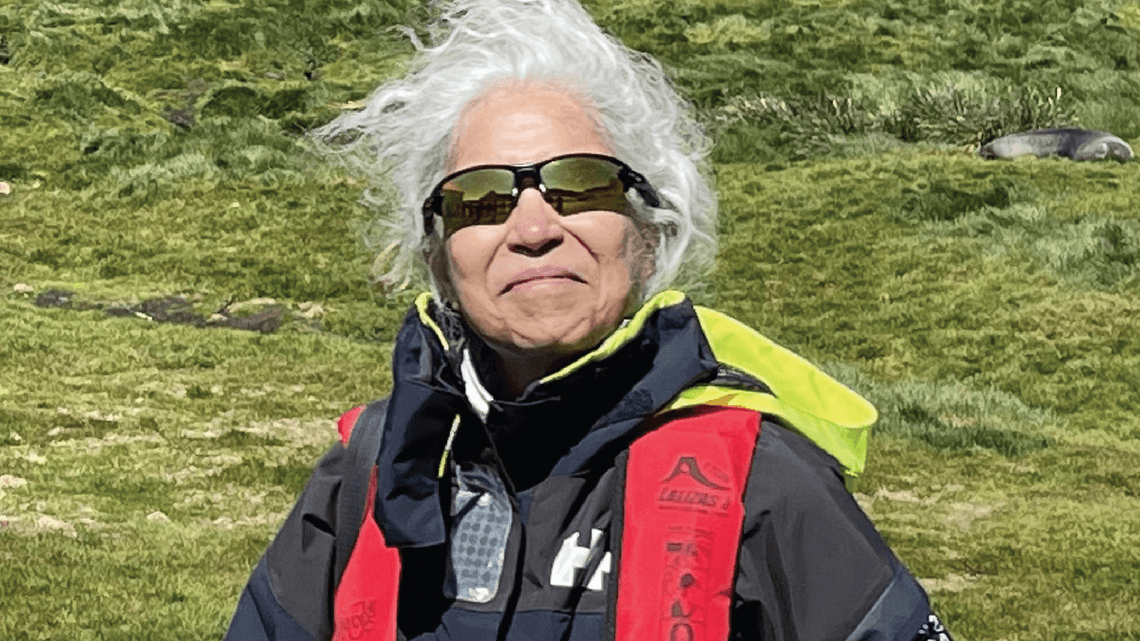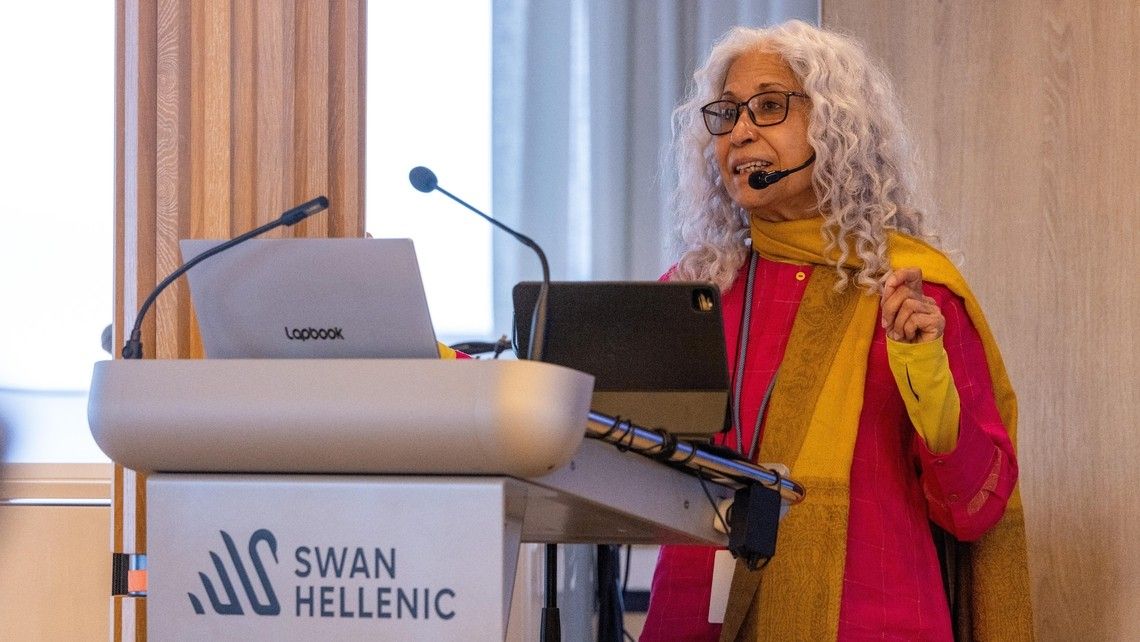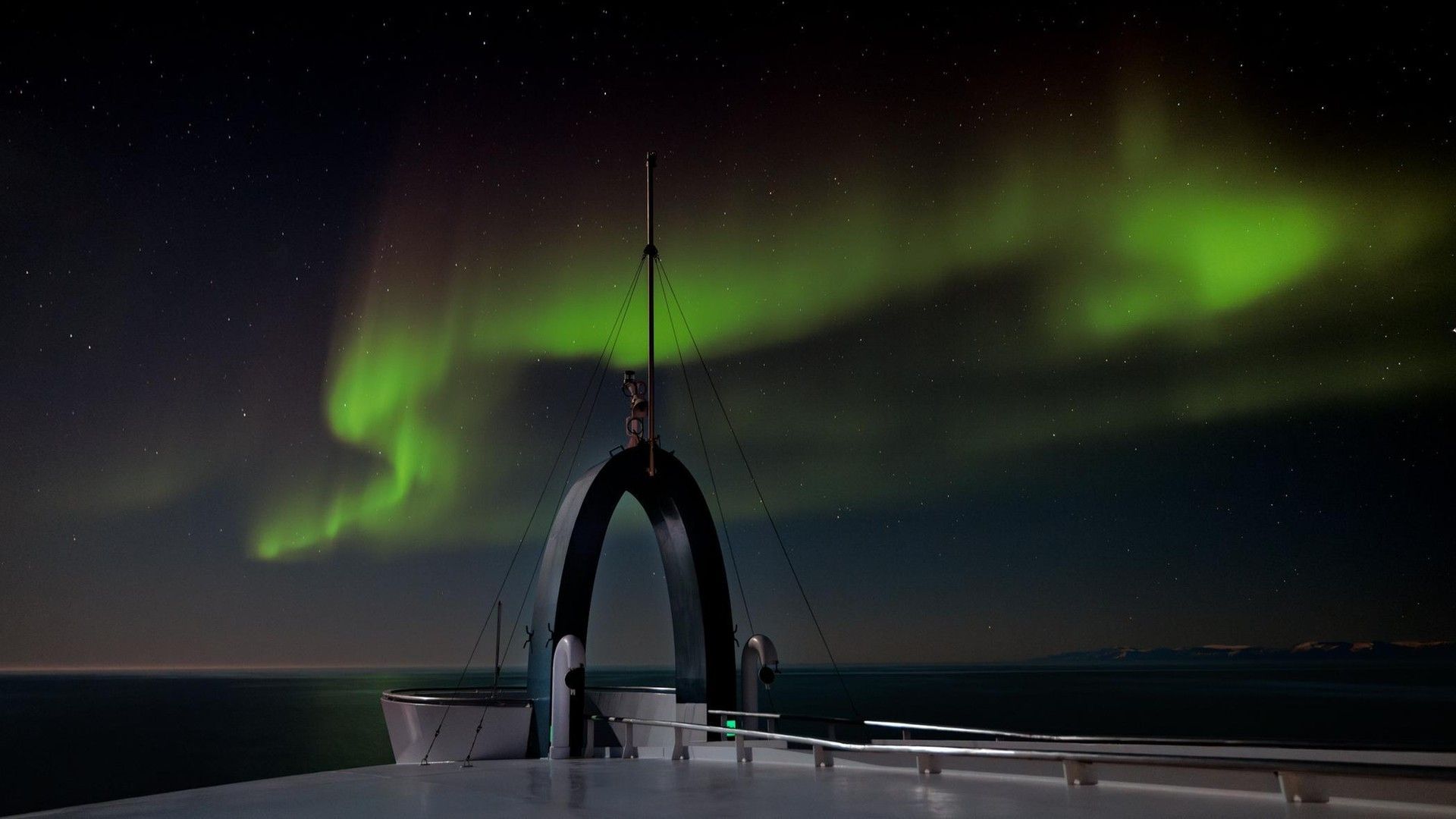«Солнце было не просто объектом моих исследований — оно помогло мне сформироваться, озаряя путь моего становления». «Затмения — это словно знаки препинания во вселенной, мгновения, когда свет и тьма замирают в космической паузе».
Мало кто знаком с Солнцем так близко как Мадхулика Гухатакурта. Учёный, рассказчица и вдохновитель, она многие годы посвятила гелиофизике, а теперь в отпуске, вдали от NASA, делится своими знаниями и открытиями с гостями экспедиционных круизов Swan Hellenic, от просторов Южного океана до особенностей арктического неба.
Мадхулика, Ваш титул «шелиофизик» звучит необычно и поэтично. Как он появился?
Мадхулика: «Термин “шелиофизик” возник как игра слов — сочетание she (“она”) и heliophysicist (“гелиофизик”). Со временем это стало чем-то большим: заявлением о моей идентичности. Для меня это большая гордость — быть женщиной, исследующей тайны Солнца в области, где долгие годы преобладали мужчины. Это мой способ заявить о себе — и в космосе, и в науке, и в эмоциональном пространстве».
Вы сказали, что ваша жизнь повторяет солнечные циклы. Что вы имели в виду?
Мадхулика:«Солнце в моей жизни не просто восходит и заходит — оно пульсирует в моём ритме, словно сердце Вселенной. Мой путь можно разделить на четыре солнечных цикла, и каждый из них — как строфа в непрерывно разворачивающемся космическом стихотворении. Первый цикл начался под небом Колорадо, где я получила докторскую степень и впервые увидела корону Солнца через коронографы и во время затмений. Я испытала благоговение перед светом и плазмой. Для меня стало открытием, что сама наука может быть священной. Второй цикл был ослепительно ярким. В Центре NASA имени Годдарда я запускала приборы в космос в рамках миссии SPARTAN 201 вместе с астронавтами. Это были годы смелости: выводить на орбиту аппараты, собирать данные и учиться управлять этой хореографией, связующей человеческую отвагу и звёздные ритмы. Солнце было столь близко, словно мы партнёры по танцу. Третий цикл — это время моего лидерства в NASA. Я помогала воплощать в жизнь такие миссии, как STEREO, SDO, Parker Solar Probe и Solar Orbiter — от замысла до запуска. Это был цикл видения: соединение науки и стратегии, убеждения и дипломатии. Солнце стало для меня не только объектом исследований, но и силой, способной объединять людей и сообщества. Сейчас я живу в четвёртом цикле — цикле возвращения к истории и мифу. Я исследую магнетизм и затмения как явления, соединяющие сознание, искусство и космос. Это глава не о командовании миссиями, а о пробуждении удивления — в других и заново в себе. Солнце сформировало меня — не только как учёного, но и как рассказчика. Оно стало не просто предметом исследований, а светом, который освещал и продолжает освещать мой путь».
Вы наблюдали за затмениями в разных частях света. Какие из них оставили самый глубокий след?
Мадхулика: «Моё первое затмение произошло в 1991 году — самое продолжительное в этом столетии. День внезапно обратился во тьму, и я впервые на интуитивном уровне ощутила, что Солнце – живой организм: оно движется, скрывается и возвращается. Затмение 2006 года над Ливией стало для меня одним из самых значимых. Научные результаты были впечатляющими, но ещё важнее оказался сам контекст: оно собрало вместе учёных из разных политических лагерей в месте, далёком от традиционной научной дипломатии. На краю Сахары мы нашли общий язык — не только в физике, но и в стремлении к миру. А «Великое американское затмение» 2017 года оказалось совершенно особенным. Тень Луны пересекла всю территорию США. Я наблюдала его в Орегоне среди тысяч охотников за затмениями, семей, коллег-учёных и тех, кто впервые поднял глаза к небу. На две с половиной минуты время словно остановилось, и миллионы людей объединились в коллективном изумлении. Это было самое невероятное затмение, которое я когда-либо видела — космическое явление превратилось в настоящий национальный праздник».
Это звучит как незабываемые события?
Мадхулика: «Да, каждое затмение — словно отпечаток пальца на небе: уникальное, мимолётное и незабываемое. Они отмечают главы моей жизни как яркие вехи. Затмение в Антарктиде в 2021 году звучало совсем в другом регистре. Я не увидела солнечную корону — у Южного океана были свои планы. Пока наше судно шло по пути полного затмения, разыгралась буря: волны вздымались, как небесный барабанный бой. И всё же произошло нечто по-настоящему невероятное. В момент кульминации, когда над тёмными облаками опустилась ещё более густая тьма, я поняла: это не была сияющая корона плазмы, за которой я гналась по континентам. Это была завуалированная, первобытная тень, опустившаяся на бушующее море. В этом хаосе Солнце напомнило мне: красота не всегда сияет. Иногда она живёт в тишине несбывшихся ожиданий, в чистой, необузданной силе природы, утверждающей себя. Даже без короны этот момент был не менее священным. Мы не видели света, но чувствовали, как небо меняется».

Покорение Солнца
Ваши лекции сочетают элементы мифологии и астрофизики. Почему это вызывает такой резонанс?
Мадхулика: «Потому что и наука, и мифы — это пути, которыми человечество всегда стремилось объяснить чудеса вселенной. Солнечные затмения в разные эпохи были драконом, пожирающим свет, божественным знаком, вратами в иные миры. Сегодня, отправляя зонд Parker Solar Probe к самому Солнцу, мы создаём новый миф — миф о мужестве и любознательности. Когда я рассказываю о ведическом Сурье или колеснице Аполлона, объясняя одновременно законы физики плазмы, я показываю людям непрерывность человеческого стремления постичь небеса».
Что больше всего удивляет людей, когда вы объясняете природу полярного сияния?
Мадхулика: «То, что полярное сияние — это не просто игра красок на небесах, а своего рода автограф солнечных бурь в атмосфере. Это поэзия, написанная взаимодействием Солнца и магнитного поля Земли. Сам факт, что невидимые заряженные частицы, пролетевшие 93 миллиона миль, могут сотворить такое светящееся чудо в нашем небе — вот в чём подлинное восхищение».
Что о сияниях могут не знать даже опытные путешественники?
Мадхулика: «Что они вовсе не симметричны. Северное и южное сияния не являются зеркальными отражениями друг друга. Эта асимметрия — знак того, как магнитосфера Земли на самом деле борется и взаимодействует с солнечным ветром. Даже самые “зеркальные” явления природы таят в себе скрытую дисгармонию — и в этом их красота».
Что вас больше всего вдохновляет в миссии Parker Solar Probe?
Мадхулика: «Parker — это наш Икар, только с тепловым щитом и научными приборами вместо крыльев из птичьих перьев, скрепленных воском. Десятилетиями учёные пытались разгадать тайны солнечной короны издалека: почему она горячее поверхности Солнца? Что разгоняет солнечный ветер? Теперь Parker впервые летит сквозь эти области, не только наблюдая, но и буквально прикасаясь к плазме. Это переломный момент не только для гелиофизики, но и для всего нашего понимания атмосфер звёзд и космической погоды».
Вы назвали солнечные вспышки «фейерверком Солнца». Почему они важны для людей на Земле?
Мадхулика: «Солнечные вспышки — это внезапные выбросы энергии, своеобразные “икоты” звезды, которые способны поколебать привычный порядок на Земле. Они могут нарушать радиосвязь, искажать GPS, выводить из строя спутники. Для большинства людей космическая погода кажется чем-то далёким и абстрактным — пока не задерживается рейс или не мерцают огни в электросети. Эти всплески напоминают нам: наша планета — часть гораздо более широкой космической экосистемы».

Наука чудес
Что важного гости вынесут из ваших лекций на борту Swan Hellenic?
Мадхулика: «Я надеюсь, что они ощутят родство — с космосом, с людьми рядом и с бесчисленными поколениями любознательных умов, которые веками поднимали глаза к небу с тем же вопросом: “почему?”. Не нужно быть учёным, чтобы быть исследователем. Каждый вопрос о Солнце — это продолжение древнейшей традиции человечества».
Что вам интересно исследовать дальше в вашем солнечном пути?
Мадхулика: «Меня увлекает, как искусственный интеллект и наука о данных меняют наше понимание Вселенной. Хочу увидеть, как машины помогут расшифровать сложные ритмы Солнца и его влияние на Землю. А лично я жду возможности создавать новые истории — где наука переплетается с искусством и голосом. Возможно, даже музыкальную оду солнечному ветру».
Вы путешествовали по континентам, чтобы своими глазами наблюдать солнечные затмения. Что до сих пор вас в них так притягивает?
Мадхулика: «Затмения — это космические знаки препинания, мгновения, когда свет и тень замирают в небесной паузе. Меня восхищает, что каждое затмение неповторимо: цвет неба, поведение животных, эмоциональная канва. Они словно сонеты, написанные самой Вселенной, каждый в своей тональности».
Как вы объясняете космическую погоду людям, путешествующим в полярных регионах?
Мадхулика: «В полярных широтах вы оказываетесь на передовой космической погоды — там, где магнитный щит Земли открывает свои завесы солнечному ветру. Солнце непрерывно излучает поток заряженных частиц, и именно у полюсов они наиболее активно взаимодействуют с нашей планетой. Линии магнитного поля словно впускают их в атмосферу, и частицы начинают танцевать невидимыми траекториями. Результат? Полярные сияния — конечно. Но и не только: помехи в радиосигналах, сбои GPS, мерцающий спутниковый сигнал. Я объясняю гостям: если ваш приёмник трещит, а навигация вдруг «теряется», это может быть не ошибка техники, а Солнце, тихо касающееся судна своим невидимым дыханием. Даже в ясный день на море оно способно взбудоражить пространство вокруг нас. Мы привыкли думать о погоде как о дожде или ветре, но у космоса есть своя собственная погода — и, подобно земным штормам, солнечные бури могут менять маршруты рейсов, сбивать системы навигации или ослеплять спутники радиацией».
Вдали от городских огней, как эти природные условия помогают изучать космос?
Мадхулика: «Без света городов небо возвращается к нам во всей своей первозданной силе. Пояс Ориона и Млечный Путь перестают быть абстракцией и становятся спутниками. В такие моменты наука перестаёт быть просто знанием — она превращается в личный, почти интимный опыт».

Мудрость и звезды
Что по вашему мнению, люди должны знать о Солнце?
Мадхулика: «Солнце — это вовсе не статичный огненный шар. Это динамичная, живая звезда со своими настроениями, ритмами и вспышками. Оно дышит магнитными петлями, поёт плазменными волнами и формирует саму среду нашей Солнечной системы. Понять Солнце — значит постичь сам двигатель жизни».
Как изучение Солнца изменило ваше восприятие Земли?
Мадхулика: «Оно научило меня испытывать благоговение. Земля — не изолированная точка в космосе, а хрупкая планета в колыбели солнечного ветра, защищённая магнитным щитом и согреваемая изменчивой звездой. Гелиофизика показала мне, насколько тонко устроено это равновесие и как глубоко мы связаны с силами за пределами нашей атмосферы».
Какой совет вы бы дали начинающим учёным и космологам?
Мадхулика: «Любопытство на первом месте. Космология живёт благодаря пересечению идей, дисциплин и взглядов. Изучайте математику, но также учитесь удивляться. Ищите наставников, путешествуйте, читайте мифы наряду с научными журналами. Помните: ваша уникальная точка зрения — это ваша суперсила».
Как началась ваша связь с SETI?
Мадхулика: «Моя любовь к SETI появилась задолго до формального участия. Всё началось с вопроса: “Мы одни?” Я помню своё первое знакомство с уравнением Дрейка — это было не просто уравнение, а поэма, написанная переменными, где каждая составляющая шептала о возможности. Оно дало форму моему удивлению и открыло пространство для мечтаний на языке науки. Изучая наше Солнце — источник энергии, химии и ритма, — я неизбежно задавалась вопросом: а что насчёт других звёзд? Какие танцы рождаются в их свете? Для меня SETI — это не только поиск сигналов. Это зеркало. Оно приглашает нас слушать, но также размышлять о том, кто мы, что ценим и как можем быть восприняты за пределами звёзд. SETI ставит науку на службу благоговению — и именно там я всегда ощущала своё место».
Как изучение Солнца связано с поиском жизни за пределами Земли?
Мадхулика: «Наше Солнце одновременно обычное и уникальное. Его изучение даёт нам эталон — своего рода космическую свечу. А поиск жизни в других мирах расширяет горизонты воображения. Первое — это углубление, второе — расширение. Оба пути требуют смирения: одно учит нас, как работают звёзды, другое заставляет задуматься о том, почему мы важны».
Какую роль играет наука о Солнце в поиске пригодных для жизни миров?
Мадхулика: «Жизнь планеты определяется её звездой. Солнечная наука даёт нам ключи для моделирования излучения, магнитных полей и потоков частиц, которые формируют атмосферу, химический состав и даже возможность зарождения биологии. Без понимания природы звёзд мы остаёмся слепыми архитекторами, пытающимися проектировать картину пригодности для жизни в космосе».
